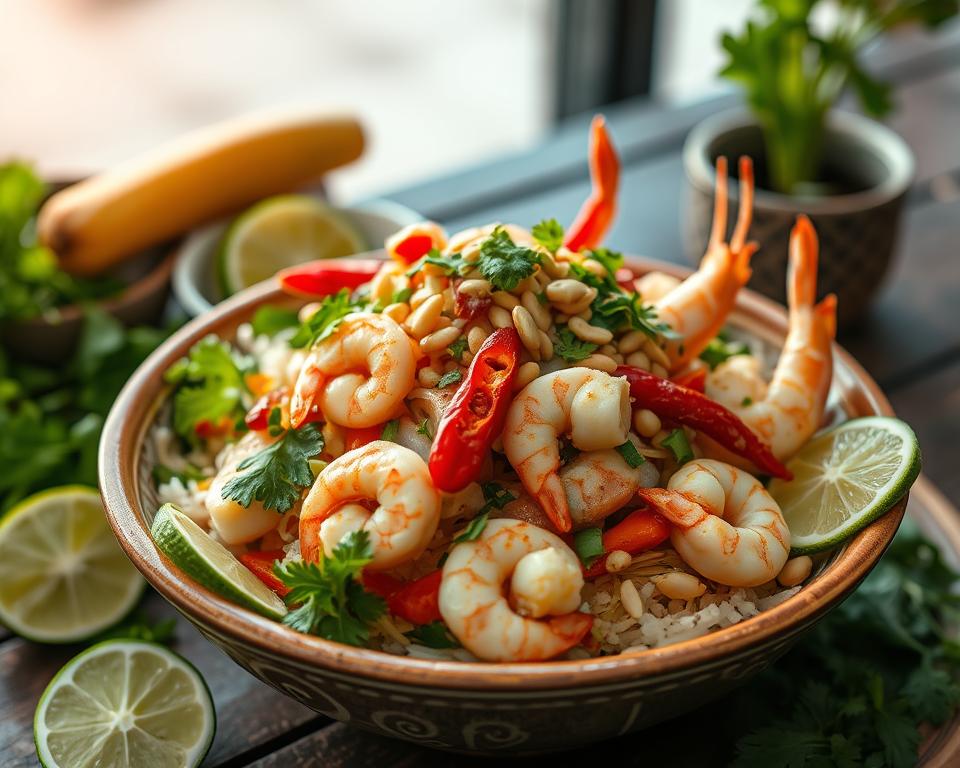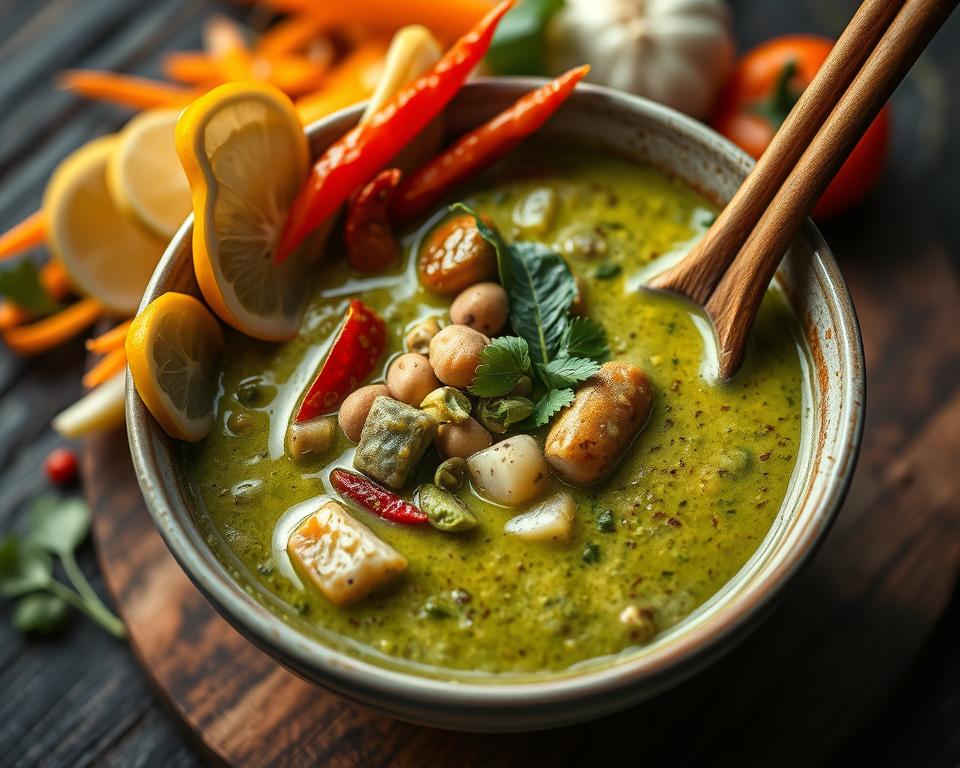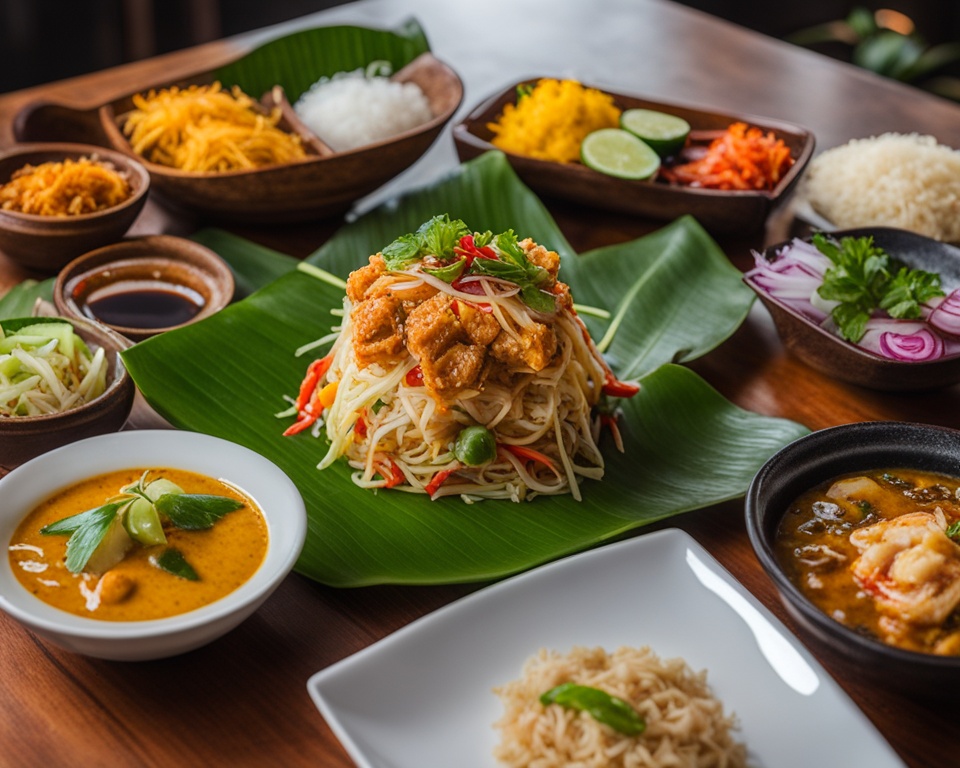
Thailand is renowned for its vibrant and diverse culinary culture, featuring a wide array of flavorful and iconic dishes. While the country boasts a vast repertoire of popular Thai dishes, the most eaten food in Thailand is undoubtedly rice. Rice is a quintessential part of the Thai diet and is deeply ingrained in the nation’s culinary traditions.
Read more interesting information at ::nanbacity
Introduction to Thai Cuisine
Thai cuisine is celebrated for its unique blend of flavors, drawing influences from various regional and cultural traditions. From the fiery curries of the South to the fragrant rice dishes of the North, Thailand’s culinary landscape is characterized by a harmonious balance of sweet, sour, salty, and spicy elements. The diversity of Thai cuisine is a testament to the country’s rich history and the interplay of different regional culinary styles.
Thailand’s Culinary Diversity
Thailand’s diverse geography and diverse cultural heritage have given rise to distinct regional Thai cuisines, each with its own unique flavors and specialties. Northern Thai cuisine is known for its mild, aromatic dishes, such as Khao Soi and Laab. The Southern region boasts fiery curries and seafood-based dishes, while Northeastern Thai cuisine (Isan) is celebrated for its bold, spicy flavors and sticky rice.
Regional Influences on Thai Dishes
The regional Thai cuisines are a testament to the country’s rich cultural tapestry, with each region contributing its own distinct culinary traditions and flavor profiles. These regional influences have shaped the diverse array of popular Thai dishes that have captured the global palate, making Thai cuisine a highly sought-after and beloved culinary experience.
Staple Foods in Thailand
At the heart of Thai cuisine lies the staple foods that form the foundation of the country’s eating habits. Rice, in its many varieties, is undoubtedly the most prominent and widely consumed food in Thailand. From the fragrant jasmine rice to the sticky glutinous varieties, this versatile grain is deeply ingrained in the Thai culinary tradition and plays a central role in the daily meals of the Thai people.
The Importance of Rice
Rice is not just a food item in Thailand; it is a way of life. Thai people consume rice multiple times a day, often as the main component of their meals. The preparation and consumption of rice are closely tied to the country’s cultural identity, social customs, and even religious practices. Whether served alongside savory curries, stir-fried dishes, or as the base for beloved rice-based specialties, rice remains the unifying staple that brings Thai families and communities together around the table.
Noodles: A Thai Favorite
While rice may be the undisputed most eaten food in Thailand, noodles also play a significant role in the country’s culinary landscape. Thai cuisine features a vast array of noodle dishes, each with its own unique regional influence and flavor profile. From the iconic Pad Thai to the aromatic Khao Soi, noodles are embraced as a beloved staple food in Thailand and an integral part of the country’s eating habits.
Popular Thai Dishes
Thai cuisine is renowned for its array of delectable and iconic dishes that have captivated the global palate. Some of the most popular Thai dishes include Tom Yum Goong, a fiery and aromatic shrimp soup; Pad Thai, the quintessential Thai-style fried noodle dish; and Som Tam, a spicy and refreshing green papaya salad. These popular Thai dishes, among others, have become synonymous with the vibrant and flavorful culinary culture of Thailand.
Tom Yum Goong (Spicy Shrimp Soup)
Tom Yum Goong is a beloved famous Thai recipe that showcases the harmonious balance of flavors in Thai cuisine. This iconic dish features a fragrant and zesty broth, brimming with fresh shrimp, lemongrass, kaffir lime leaves, and a variety of aromatic herbs and spices. The combination of sour, spicy, and savory elements creates a truly captivating dining experience.
Pad Thai (Thai-style Fried Noodles)
Pad Thai, the quintessential popular Thai dish, is a stir-fried noodle creation that has become a global ambassador for Thai cuisine. This dish features rice noodles, shrimp or chicken, bean sprouts, crushed peanuts, and a delectable sweet and tangy sauce, all coming together in a harmonious medley of flavors and textures.
Som Tam (Spicy Green Papaya Salad)
Som Tam, a refreshing and famous Thai recipe, is a vibrant salad that showcases the bold and spicy flavors of Northeastern Thai (Isan) cuisine. Shredded green papaya is tossed with a tantalizing blend of chili peppers, lime juice, fish sauce, and a variety of crunchy vegetables, creating a dish that is both invigorating and addictive.
What is the Most Eaten Food in Thailand?
While Thailand’s culinary landscape is diverse, the most eaten food in the country is undoubtedly rice. Rice holds a central position in the Thai diet and is considered a staple food. Thai people consume various types of rice, each with its unique characteristics and applications in Thai cuisine.
Rice: The Staple Diet of Thai People
Rice is deeply ingrained in the Thai culinary tradition and plays a pivotal role in the daily lives of the Thai people. It is a fundamental component of the Thai diet, accompanying nearly every meal and serving as the foundation for countless beloved dishes. The importance of rice in Thai culture is reflected in the variety of rice cultivated and consumed throughout the country.
Varieties of Rice Consumed in Thailand
Thai people enjoy a wide range of rice varieties, each with its own distinct flavor, texture, and culinary applications. Some of the most popular types of rice consumed in Thailand include:
- Jasmine Rice – A fragrant, long-grain variety known for its delicate aroma and fluffy texture.
- Sticky Rice – A glutinous rice variety popular in the northern and northeastern regions, often used in traditional desserts and savory dishes.
- Hom Mali Rice – A premium, aromatic rice cultivar revered for its exceptional taste and quality.
These diverse rice options allow Thai cooks to create a harmonious balance of flavors and textures in their culinary creations, showcasing the central role of this staple food in Thai eating habits and cultural traditions.
Thai Street Food Culture
The vibrant street food culture is an integral part of Thailand’s culinary landscape. Thai street food stalls and vendors offer a wide array of delectable and affordable dishes, showcasing the country’s diverse street food in thailand traditions. From savory noodle dishes to sweet desserts, the variety of popular street food items in Thailand is a testament to the nation’s love for flavorful and accessible cuisine.
Street Food Stalls and Vendors
Dotting the bustling streets and alleyways of Thai cities, vibrant street food stalls and mobile vendors serve as the heartbeat of the country’s thai culinary culture. These dynamic food hubs offer a captivating sensory experience, with the sizzle of woks, the fragrance of spices, and the lively chatter of both vendors and customers creating an unforgettable atmosphere.
Popular Street Food Items
Thailand’s street food scene boasts a diverse array of beloved dishes that have become synonymous with the country’s culinary heritage. From the savory delights of Pad Thai (Thai-style fried noodles) and Som Tam (spicy green papaya salad) to the sweet indulgences of Moo Ping (grilled pork skewers) and Khao Niaow Ma Muang (sticky rice with mango), these popular street food items showcase the depth and versatility of Thai cuisine.
Regional Thai Cuisine
Thailand’s diverse geography and cultural heritage have given rise to distinct regional cuisines, each with its own unique flavors and specialties. These regional culinary traditions contribute to the richness and diversity of thai culinary culture.
Northern Thai Cuisine
Northern Thai cuisine is known for its mild, aromatic dishes, such as Khao Soi and Laab. The region’s proximity to neighboring countries has influenced its culinary style, resulting in a balance of flavors that is often less spicy than other Thai regional cuisines.
Southern Thai Cuisine
The Southern region of Thailand boasts fiery curries and seafood-based dishes. The abundance of coastal resources and the influence of Malaysian and Indonesian cuisines have shaped the bold and complex flavors of regional thai cuisine in this part of the country.
Northeastern Thai Cuisine (Isan)
Northeastern Thai cuisine, also known as Isan, is celebrated for its bold, spicy flavors and the prominent use of sticky rice. This region’s culinary traditions reflect the area’s agricultural heritage and the proximity to Laos and Cambodia.
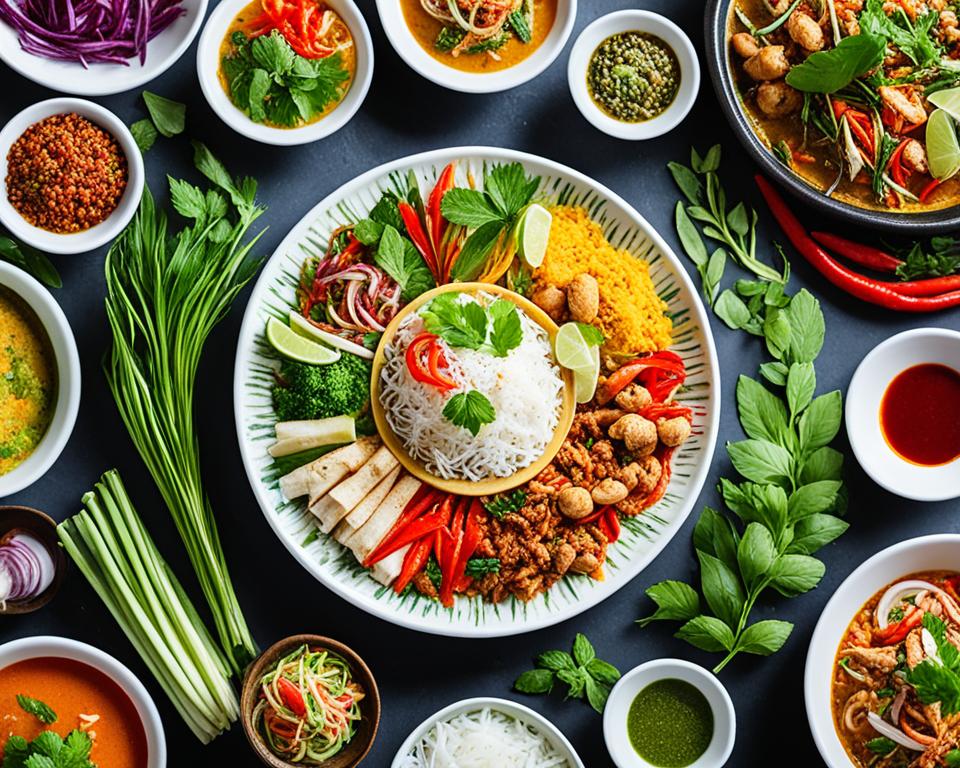
Thai Culinary Traditions
Thai culinary traditions are deeply rooted in the country’s rich thai culinary culture, history, and natural environment. The use of fresh, locally sourced ingredients and the harmonious balance of flavors, such as sweet, sour, salty, and spicy, are hallmarks of traditional thai food.
Ingredients and Flavors
Thai cuisine is renowned for its vibrant and complex flavors, which are carefully cultivated through the skillful selection and preparation of ingredients. From the fragrant lemongrass and galangal to the fiery chilies and aromatic herbs, each component plays a crucial role in creating the distinctive taste profiles that define Thai dishes.
Cooking Techniques and Utensils
The unique character of Thai cuisine is further shaped by the specialized cooking techniques and specialized utensils employed in Thai kitchens. The wok, a versatile pan essential for stir-frying, and the mortar and pestle, used for grinding spices and preparing paste-based sauces, are just two examples of the tools that have become integral to the thai culinary culture.
Influence of Thai Cuisine Globally
Thai cuisine has gained global recognition and popularity, with Thai restaurants and eateries now found in every corner of the world. The allure of Thai flavors, from the fragrant curries to the vibrant stir-fries, has captivated the palates of food enthusiasts across the globe, leading to the widespread proliferation of Thai culinary establishments.
Thai Restaurants Around the World
The proliferation of Thai restaurants worldwide is a testament to the enduring appeal of Thai cuisine. From bustling metropolitan cities to quaint rural towns, Thai restaurants have become a ubiquitous presence, offering diners an opportunity to immerse themselves in the rich and diverse flavors of popular Thai dishes. These establishments not only serve as hubs for authentic Thai cuisine but also serve as cultural ambassadors, introducing the intricacies of Thai culinary culture to international audiences.
Fusion and Modern Thai Cuisine
Beyond the traditional Thai dishes, the influence of Thai cuisine has extended to the realm of fusion and modern culinary interpretations. Chefs around the globe have embraced the bold and complex flavors of Thai cuisine and have adapted them to create innovative and creative culinary experiences. These fusion dishes seamlessly blend Thai ingredients, techniques, and flavor profiles with local and international culinary traditions, resulting in a harmonious and often unexpected gastronomic journey. The emergence of these modern Thai recipes has further expanded the reach and appeal of Thai cuisine on a global scale.
Health Benefits of Thai Food
Thai cuisine is not only delicious but also widely recognized for its health benefits. The use of fresh, locally sourced ingredients, such as herbs, vegetables, and lean proteins, combined with the balanced interplay of flavors, contribute to the nutritional value of Thai dishes. The emphasis on a diverse array of vegetables, the incorporation of anti-inflammatory spices, and the overall balance of nutrients make Thai food a healthful and nourishing cuisine.
Use of Fresh Ingredients
One of the hallmarks of Thai culinary culture is the commitment to using fresh, locally sourced ingredients. Thai chefs place a strong emphasis on incorporating a wide variety of vegetables, from aromatic lemongrass to crisp bean sprouts, into their dishes. This abundance of fresh produce not only adds vibrant colors and textures to Thai cuisine but also provides a wealth of essential vitamins, minerals, and antioxidants.
Balance of Flavors and Nutrients
The signature balance of sweet, sour, salty, and spicy flavors in Thai cuisine is not just a culinary delight but also a testament to the holistic approach to nutrition. The interplay of these diverse flavors is achieved through the careful selection and combination of ingredients, including anti-inflammatory spices like turmeric, galangal, and chili peppers. This balanced approach to flavors ensures that Thai dishes offer a well-rounded nutritional profile, catering to the overall health and well-being of the consumer.
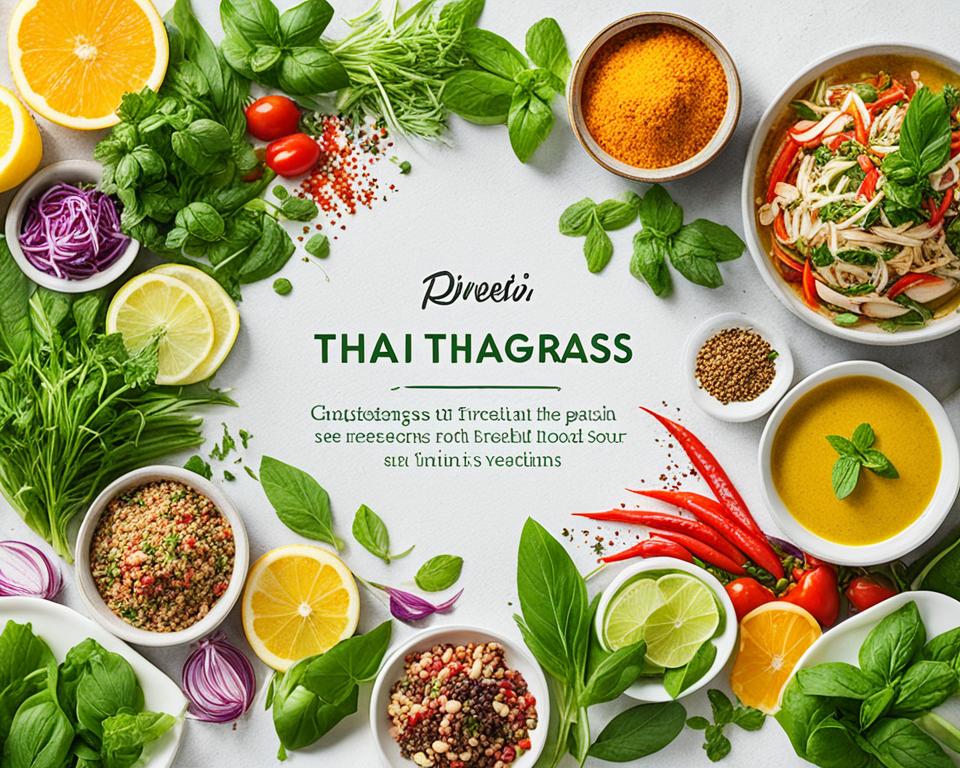
Vegetarian and Vegan Options in Thai Cuisine
Thai cuisine is renowned for its vibrant flavors and diverse ingredients, and it also offers an abundance of vegetarian and vegan options that cater to a wide range of dietary preferences. Many traditional Thai dishes can be easily adapted to accommodate plant-based diets, with substitutions for animal-based ingredients such as meat, dairy, or fish.
The key to the success of vegetarian and vegan Thai food lies in the abundance of fresh produce, aromatic herbs, and versatile cooking techniques employed by Thai chefs. From the fragrant lemongrass and kaffir lime leaves to the fiery chilies and fragrant spices, these ingredients form the foundation of numerous Thai cuisine dishes that can be seamlessly transformed into delectable vegetarian or vegan creations.
| Vegetarian Thai Dish | Vegan Thai Dish |
|---|---|
| Pad Thai (with tofu) | Som Tam (spicy green papaya salad) |
| Red Curry with Vegetables | Khao Niaow Ma Muang (sticky rice with mango) |
| Larb Hed (mushroom salad) | Massaman Curry with Roasted Vegetables |
The versatility of Thai cuisine allows chefs to create flavorful and satisfying plant-based dishes that seamlessly fit into the overall culinary landscape. Whether it’s a classic Thai curry, a nourishing salad, or a delectable dessert, the vegetarian and vegan options in Thai cuisine offer a delightful and accessible way for diners to explore the depths of this vibrant and diverse culinary tradition.
Desserts and Sweets in Thai Culture
Thai cuisine is not only renowned for its savory dishes but also for its delectable desserts and sweets. From traditional Thai desserts that showcase the country’s expertise in crafting sweet treats to modern dessert trends that push the boundaries of the Thai culinary landscape, the world of Thai sweets is a delightful and captivating exploration.
Traditional Thai Desserts
Among the iconic traditional Thai desserts, Khao Niaow Ma Muang, a dish of sticky rice with fresh mango, and Khanom Chan, a layered sweet cake, stand out as exemplary representations of the country’s mastery in the art of dessert making. These timeless treats embody the harmony of flavors and textures that are hallmarks of Thai culinary culture.
Modern Thai Dessert Trends
In recent years, the Thai dessert landscape has witnessed a surge of innovation and creativity, as chefs and pastry artisans have embraced new techniques and flavor combinations. From reinvented versions of classic traditional Thai food sweets to fusion desserts that blend Thai elements with global influences, the modern Thai dessert trends have expanded the boundaries of the country’s culinary offerings, delighting both local and international palates.
Thai Eating Habits and Customs
Thai eating habits and customs are deeply rooted in the country’s rich culinary culture. Meals in Thailand are often enjoyed in a family-style setting, where an array of dishes are placed in the center of the table and shared among diners.
Family-Style Dining
The act of sharing food and coming together around the table is highly valued in Thai culture. This family-style dining approach fosters a sense of community and strengthens social bonds, as individuals partake in the shared experience of savoring a variety of Thai culinary delights.
Importance of Sharing Meals
The importance of sharing meals in Thai culture extends beyond just the act of eating. It represents a deeper appreciation for the communal aspect of dining, where conversations, connections, and a deeper understanding of one another are cultivated over the shared experience of enjoying flavorful Thai dishes.
Tips for Enjoying Thai Food
To fully immerse oneself in the vibrant world of Thai cuisine, it is essential to understand the nuances and customs associated with enjoying Thai food. Whether dining at a local Thai restaurant or exploring the bustling Thai street food scene, a few key tips can enhance the overall experience and allow for a deeper appreciation of this captivating culinary tradition.
Navigating Thai Restaurant Menus
When visiting a Thai restaurant, it is helpful to familiarize oneself with the various dish categories and regional specialties. Thai menus often feature a diverse array of Thai cuisine, from the aromatic curries of the South to the noodle dishes of the North. Understanding the different menu sections and the specific ingredients and preparation methods of popular Thai dishes can guide diners in making informed choices that align with their preferences.
Understanding Thai Spice Levels
One of the hallmarks of Thai cuisine is the interplay of flavors, including the use of spices and chili peppers. Thai dishes often feature varying degrees of spice, from mild and fragrant to fiery and intense. Being mindful of one’s tolerance for spice and communicating preferences to the server can ensure a thoroughly enjoyable dining experience. Exploring the nuances of street food in Thailand and gradually acclimating to the spice levels can also be a rewarding way to immerse oneself in the country’s culinary traditions.
Conclusion
In the diverse and vibrant culinary landscape of Thailand, rice stands out as the most eaten food, a staple that is deeply ingrained in the country’s food culture and traditions. From the fragrant jasmine rice to the sticky varieties, rice serves as the foundation for numerous beloved Thai dishes, showcasing the centrality of this ingredient in the Thai diet. Beyond rice, the Thai culinary experience encompasses a vast array of flavorful and iconic dishes, each with its unique regional and cultural influences. Through the exploration of Thailand’s culinary diversity, one can truly appreciate the depth and richness of this captivating cuisine.
The staple foods in Thailand, such as rice and noodles, play a significant role in shaping the country’s eating habits and culinary traditions. From the street food culture to the renowned regional Thai cuisines, the Thai culinary landscape is a vibrant tapestry of flavors, techniques, and customs that have captivated the global palate. Whether it’s the fiery curries of the South, the fragrant rice dishes of the North, or the bold, spicy flavors of Isan, each facet of Thai cuisine offers a unique culinary journey for the discerning food enthusiast.
As the world continues to embrace the allure of Thai cuisine, the popularity of Thai dishes and the global influence of Thai culinary culture only continue to grow. From the ubiquitous Pad Thai to the iconic Tom Yum Goong, the famous Thai recipes have become synonymous with the vibrant and captivating flavors that define the essence of Thai culinary traditions. By delving into the depths of this remarkable cuisine, one can truly appreciate the richness, complexity, and enduring appeal of what is the most eaten food in Thailand.
